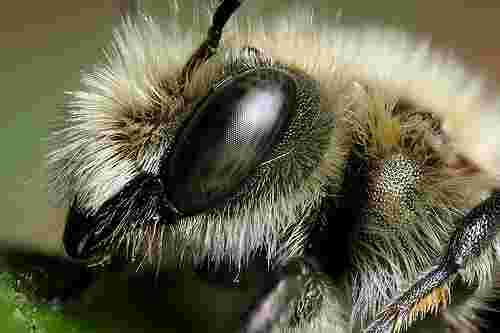Several species of bees nest in crevices or holes in masonry and are known as 'mason' or 'mortar' bees (these names are also used for bees that construct their nests from mud). They are most often found in walls that receive sunshine for much of the day. The spaces beneath roofing tiles and behind ventilator grills in walls are also occasionally used as nesting sites by the Red Mason Bee. Females use naturally-occurring holes in either the bricks themselves or, more usually, in the mortar joints (especially soft mortar, with a high lime or sand content). Some females may also be able to excavate burrows in intact, but soft mortar. Nesting burrows are excavated or enlarged by use of the bee's mandibles and the resulting spoil is kicked out of the burrow entrance. These bees do not eat the mortar or brickwork.
Life-cycleNests in mortar generally consist of a single burrow, or a series of branching burrows each terminating in one or more circular or oval chambers known as cells. Where more space is available a honeycomb-like aggregation of cells may be built by the Red Mason Bee. A completed nest usually contains about six to twelve cells, the number varying with the species and the site chosen. The cells are provisioned with a mixture of pollen and nectar, and an egg laid on this 'pollen loaf'. When completed and provisioned each cell is sealed, usually with soil. Depending on the species, the winter is passed either as newly developed adults which remain for this period in their unopened cells (as in most spring-flying bees), or as full-fed larvae (summer-flying bees).
Damage and controlAlthough these bees are solitary nesters (i.e. each female establishes and provisions her own nest independently of others), they sometimes occur in aggregations, with nests very close to one another. The annual burrowing activities of numerous bees may undermine brickwork and in very rare instances can seriously weaken the fabric of a wall. As the bees boring activities are limited to comparatively weak materials the most effective method of preventing further damage is the re-pointing of affected areas. The joints need to be raked out to a depth of at least 15mm and then pointed with a mortar that is not too strong for the brick, but sufficiently hard to discourage the bees. For brickwork a 1:2:9 cement/lime/sand, or 1:8 cement/sand with plasticiser should be adequate, provided it is used when frosts are unlikely. If there is a risk of frost a 1:1:6, cement/lime/sand, or 1:6 cement/sand with plasticiser should be used. For some stonework or brickwork where the stone or bricks are fairly weak a 1:1:6 mortar may be too strong and it would be better to use a 1:2:9 or 1:9 with plasticiser and ensure that the work is done in a frost free period. In cases where the activity is in the actual bricks or stone, a regular spray treatment in early spring may be the only effective method of control. An alternative to this would be to render the whole surface with a mix not stronger than a 1:1:6 cement/lime/sand mix and preferably a 1:2:9 mixture. Pointing is generally best carried out during late summer or autumn. This avoids both frost and the activities of the bees. If the work can only be done in spring an insecticide spray or dust should be injected into the gallery entrances and the wall sprayed with the same solution after pointing to prevent attack on the mortar before it fully hardens. Wettable powder and emulsion residual insecticides are suitable for this purpose.

Chemical treatment alone is not always effective in the long-term, and may stain masonry. It is also ecologically undesirable, though there may be little alternative in rare cases where bees are nesting in actual bricks or stones. Water-based insecticide is also sometimes added to mortar mixes, particularly when re-pointing in the spring rather than late summer or autumn, and a risk exists of damage before the mortar hardens. However, an easier method may be to harden the existing mortar by application of sealing fluid which can be painted onto the joints. Insecticides may not be effective.
The provision of artificial nesting boxes on or near walls can help entice bees away from them and prevent re-colonisation. These can be home-made from dried clay soil indented with holes or, alternatively, proprietary kits are available manufactured from environmentally-friendly materials. All you need to do is place the bee nest boxes in sunny, sheltered, south-facing position in the garden and you will attract nest-seeking females of the Red Mason Bee in early spring. No work is required - if the nest boxes are in the garden at the right time the bees will find them.